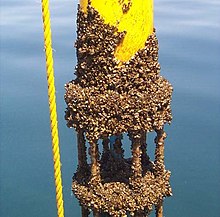
Back حشف حيوي Arabic Fouling (Schiffbau) German Bioincrustación Spanish Biosaaste Estonian Encrassement biologique French צימדה ימית (ביופאולינג) HE Ásætur Icelandic Қаптап өсу Kazakh Bioincrustação Portuguese Обрастание Russian


Biofouling or biological fouling is the accumulation of microorganisms, plants, algae, or small animals where it is not wanted on surfaces such as ship and submarine hulls, devices such as water inlets, pipework, grates, ponds, and rivers that cause degradation to the primary purpose of that item. Such accumulation is referred to as epibiosis when the host surface is another organism and the relationship is not parasitic. Since biofouling can occur almost anywhere water is present, biofouling poses risks to a wide variety of objects such as boat hulls and equipment, medical devices and membranes, as well as to entire industries, such as paper manufacturing, food processing, underwater construction, and desalination plants.
Anti-fouling is the ability of specifically designed materials (such as toxic biocide paints, or non-toxic paints)[1] to remove or prevent biofouling.[2]
The buildup of biofouling on marine vessels poses a significant problem. In some instances, the hull structure and propulsion systems can be damaged.[3] The accumulation of biofoulers on hulls can increase both the hydrodynamic volume of a vessel and the hydrodynamic friction, leading to increased drag of up to 60%.[4] The drag increase has been seen to decrease speeds by up to 10%, which can require up to a 40% increase in fuel to compensate.[5] With fuel typically comprising up to half of marine transport costs, antifouling methods save the shipping industry a considerable amount of money. Further, increased fuel use due to biofouling contributes to adverse environmental effects and is predicted to increase emissions of carbon dioxide and sulfur dioxide between 38% and 72% by 2020, respectively.[6]
- ^ Cite error: The named reference
antifouling_reviewwas invoked but never defined (see the help page). - ^ Cite error: The named reference
Vladkovawas invoked but never defined (see the help page). - ^ L.D. Chambers; et al. (2006). "Modern approaches to marine antifouling coatings" (PDF). Surface and Coatings Technology. 6 (4): 3642–3652. doi:10.1016/j.surfcoat.2006.08.129.
- ^ Vietti, Peter (4 June 2009), New hull coatings for Navy ships cut fuel use, protect environment, Office of Naval Research, retrieved 21 May 2012
- ^ Vietti, P. (Fall 2009). "New Hull Coatings Cut Fuel Use, Protect Environment" (PDF). Currents: 36–38. Archived from the original (PDF) on 5 October 2011. Retrieved 6 June 2011.
- ^ Salta, M.; et al. (2008). "Designing biomimetic antifouling surfaces". Philosophical Transactions of the Royal Society. 368 (1929): 4729–4754. Bibcode:2010RSPTA.368.4729S. doi:10.1098/rsta.2010.0195. PMID 20855318.